Abstract
This paper aims to identify the best solution for three SOx scrubber systems by evaluating their economic, environmental and technical performances: open-loop, closed-loop and hybrid scrubber systems. It adopted a novel muti-criteria decision-making model which can be introduced as the combination of lifecycle cost and lifecycle assessments, and fuzzy-TOPSIS and fuzzy-AHP. The analysis results of the case study of 72,100 gross-ton cargo ships suggested that the closed-loop scrubber systems would be the most effective in the consideration of all of the aspects, overall. It also shows the excellence of the proposed decision-making model to remedy the shortcomings of the conventional multi-criteria decision-making process by directing the analytic process in a wiser way, by means of fuzzy elements. For the environmental impact assessment, the lifecycle assessment approach enables one to obtain a holistic view of the Lifecycle emissions from the cradle to the grave. This paper finally shows the effectiveness of the proposed method, which can improve confidence in decision-making by extending a short-term view widely. Therefore, it was strongly believed that the proposed model is not necessarily/limitedly applied to marine systems but can be broad and noteworthy for a variety of studies requiring appropriate decision-making.
1. Introduction
1.1. Background of Scrubber Systems
At the 70th Marine Environmental Protection Committee meeting from the 24th to 26th October, 2016, IMO ratified a regulation to control the sulfur content in marine fuels to 0.5% or less from 1 January 2020. In order to meet the compliance, ship owners have been urged to choose any of the following options: (1) using low-sulfur fuels; (2) adopting LNG as marine fuel; (3) using a SOx-reducing device known as scrubber systems.
LSFO can continue to use existing marine diesel engines and reduce Sox emissions to acceptable levels without scrubber systems. However, LSFO incurs a 50% higher cost in the refining process, and the fines for catalysts for engines using LSFO are also increased, making it much less economical than the scrubber system [1].
While it is impossible to avoid an increase in ship operating costs due to these measures, SOx scrubber systems would offer some advantages of relatively cheaper fuel costs, as it continues to use high sulfur oil as the main fuel for ships compared to the existing low sulfur oil.
SOx scrubber systems are typically categorized into three types: “open-loop”, “closed-loop” and “hybrid”. The open-loop scrubber (open-loop system) reduces sulfur oxides and particulate matter in exhaust gas through chemical action using naturally alkaline seawater. In addition, the seawater that exits the scrubber goes through the process of adjusting the pH level to prevent marine pollution and is discharged back outboard.
Closed-loop systems use sodium hydroxide solution and fresh water to induce the neutralization of fresh water by sulfur oxides. In this process, seawater is used to cool fresh water used for exhaust gas cleaning. Cooled fresh water is mostly circulated for exhaust gas cleaning, but some are centrifuged. It is discharged outboard through the adjustment process of the PH level. Hybrid scrubber systems have both functionalities of open- and closed-loop systems.
On the other hand, the increased emergence of low-emission scrubbers—due to government-imposed regulations—was predicted to significantly drive the marine scrubber market during the period 2021–2026. The marine scrubber market is anticipated to reach 4.3 billion USD in 2026 from 2.5 billion USD in 2020 [2].
Given this, it is still imperative for shipowners to make a proper decision against the fierce competition by examining the advantages and disadvantages of the different SOx scrubber systems to proceed with proper decision-making.
1.2. Multi-Criteria Decision-making (MCDM)
MCDM analysis has been introduced to explicitly evaluate multiple conflicting criteria in decision-making among various options. MCDM has various different methods but uniformly provides a groundwork for choosing and categorizing, as well as prioritizing various options, and helps to facilitate the best decision-making [3].
MCDM analysis will, therefore, be an effective tool that can be directly used in examining the applicability of SOx scrubbers for marine vessels under the specific criteria considered by stakeholders.
Velasquez and Hester [4] pointed out that one of the most common MCDM methods could turn into the multiple attribute utility theory (MAUT), analytical hierarchical process (AHP), and Technique for the Order of Preference by Similarity to Ideal Solution. Simple multiple attributes known as TOPSIS, Case-Based Reasoning, Objective Programming, ELECTER, PROMETHEE and Fuzzy were also described as widely adopted methods.
Each method has been further enhanced and has shown typical patterns of improvement over the years. They were also often combined with different methods to overcome their shortcomings in finding the best solution. To determine the best options/scenarios/systems in engineering, the most common MCDM methods have been known as Analytic Hierarchy Process (AHP), Fuzzy Set Theory, and Technique for Order Preferences by similarity to Ideal Solution (TOPSIS) [4].
Pilavachi, Stephanidis, Pappas and Afgan [5] applied a conventional Analytic Hierarchy Process (AHP) to natural gas and hydrogen power plant technologies. Nine options for generating electrical energy were evaluated in relation to seven criteria. Pilavachi et al. [5] started the process utilizing a general AHP methodology. The process of decision-making in AHP was divided into three parts: goals, criteria and decision options. They pointed out that AHP tools can simplify complex problems and are typically used by decision-makers for single- and multi-objective problems.
Üçtuğ and Fahrioğlu [6] used TOPSIS to investigate the performance of different fuel cell types for electricity generation. It highlights the advantages of the TOPSIS method over other MCDM methods in terms of proper decision-making for proper fuel cells. As a result, it could help decision-makers easily distinguish similarities and contrasts between different fuel cell options.
Additionally, Jeong, Oguz, Wang and Zhou [7] developed an enhanced multi-criteria decision-making method that transforms incomparable values from different impact categories into monetary values in order not to lose any intrinsic information. They pointed out how this method unambiguously eliminates the weighting factor procedure and traditional normalization process. The key idea from their research was to convert all of the impacts into a single unit which is a monetary term. For instance, cost impacts are expressed in monetary terms and environmental impacts are revealed as quantifications of different pollution types, which were then changed as monetary values equivalent to social costs. Risk impact was again converted to money value using the Risk Priority Number (RPN). Using the proposed model, it compares the performance of ships with three marine propulsion methods: “diesel mechanical”, “diesel electric” and “hybrid” systems from economic, environmental and risk perspectives.
There have been several examples of remarkable research investigating the performance of SOx scrubber systems. Yang et al. [8] conducted an interesting study that evaluated actual gas and particulate emissions through a retrofit of a container ship to be fitted with a scrubber system. Key findings were highlighted with the excellence of the scrubber unit that reduced more than 95% sulfur dioxide (SO2) emission removal at all engine loads. Jang et al. [9] firstly applied a lifecycle assessment (LCA) technique to marine SOx scrubber systems to investigate the holistic environmental benefits of using those systems. The analysis was made in a comparative approach among the three different scrubber systems, suggesting that the closed-loop system is a relatively cleaner option. A similar study has been done by Andersson, Jeong, Jang and Shipping [10]. They also conducted a combined LCA analysis with life-cycle cost analysis (LCCA). Similar results were observed.
The past studies presented above are helpful to some extent. Nevertheless, none have completely compared different SOx scrubber systems in three key aspects: economic, environmental and technical impacts together. In this light, it was believed that an integrated MCDM needs to be employed. The aim of this paper is to identify the best option of three different SOx scrubber systems: open, closed and hybrid ones with a case ship. Meanwhile, this project will adopt the enhanced MCDA method firstly introduced by Jeong et al. [7].
2. Approach Adopted
As shown in Figure 1, the proposed method of Jeong et al. [7] will be used to consider that the three evaluation results of economic, environmental and risk have incomparable values. This approach is to convert the environmental impact into monetary value. On the other hand, the technical assessment will be completed in combination with Fuzzy-TOPSIS. Then, the final MCDM will be conducted based on AHP.
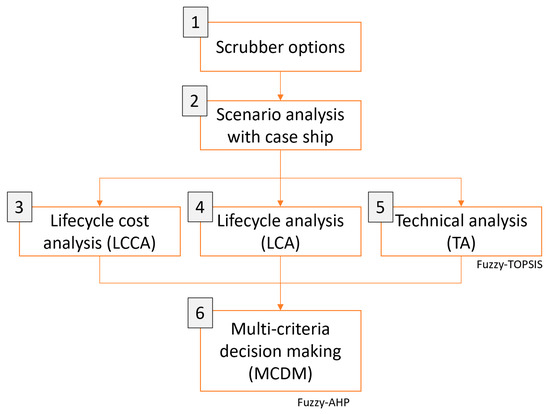
Figure 1.
Research outlines.
2.1. Scrubber Options
The scrubber system reduces the emission of sulfur oxides contained in the exhaust gas by more than 99% through chemical treatment, and at the same time, it is possible to reduce fine dust (PM, PM2.5) by 70–90%. According to the method of removing sulfur oxides, it can be divided into a wet scrubber and a dry scrubber, and the wet scrubber is further divided into an open type, a closed type or a hybrid type shown in Figure 2.

Figure 2.
Outlines of scrubber options.
2.1.1. Open-Loop Scrubber System
The open-loop scrubber system uses the principle of reducing sulfur oxide (SOx) emissions in the exhaust gas by using the alkalinity of seawater and is the simplest system among scrubber systems.
2.1.2. Closed-Loop Scrubber System
The closed-loop scrubber system reduces the emission of sulfur oxides in the exhaust gas by using caustic soda (NaOH). The seawater used to reduce sulfur oxides in the open-loop scrubber is used as cooling water in the closed-loop scrubber system, and this system must be equipped with facilities for circulation, purification and storage of caustic soda. It is attracting attention as a system with a wider usable range because it hardly discharges sewage into the sea.
2.1.3. Hybrid Scrubber System
The hybrid scrubber system adopts the functionalities of both open-loop scrubber and closed-loop scrubber systems. Although it has the most complex configuration and high installation cost among scrubber systems, it has the advantage of being able to use the two systems alternately in a timely manner.
2.2. Scenario Analysis with Case Ship
To analyse the feasibility of the installation of SOx scrubbers described in Section 2.1, a case ship which has the ECA in its service route. The ship specifications are given in Table 1. It has regular travels between Korea and the United States.

Table 1.
Case ship Specifications.
As shown in Figure 3, the case ship has a regular route from Busan, Korea to New York, U.S.A. via Los Angeles. This ship is subject to passing through US Emission Control Area (ECA) within which SOx emissions are highly limited from the engine exhaust gas either by using low sulphur fuel should be used or SOx scrubber. Table 2 presents the voyage distance between non-ECA and the ECA as well as the ratio of ECA. In other words, the case ship can use 3.5% high-sulphur fuel oil while sailing within non-ECA. Instead, the same ship needs to convert its fuel to 0.1% low-sulphur fuel or to keep using 3.5% high-sulphur fuel, it should operate a scrubber system for removal of SOx from the exhaust gas.
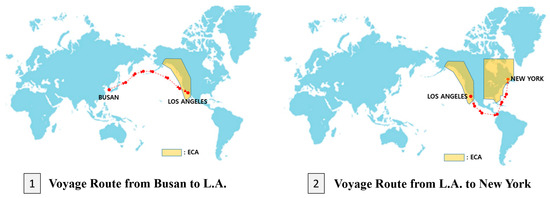
Figure 3.
Voyage routes of case ship.

Table 2.
Specification of SOx scrubber systems for the case ship (with 25 MW engine) [11].
It was estimated that the case ship annually operates for 315 days in the sea-going phase with NCR (Normal Continuous Rating) while doing 50 days at port. The fuel consumption was estimated based on this voyage profile. Table 1 also shows the Specific Fuel Oil Consumption (SFOC) for Main Engine and generators.
The abatement of PM is an important issue which apparently is not considered as a cost: PM from diesel engines is a potential carcinogenic matter and polyaromatics are easily contained in the wash waters. There are reasonably significant waste-processing costs.
2.3. Economic Impact
It is expressed as the total cost associated with various economic impacts including the cost of the scrubber system. It should be noted that the lower-cost option has a better impact at the decision-making stage. In this paper, considering the life stage of the scrubber, the total cost was estimated by dividing the scrubber’s cost, installation, operation, maintenance and scrapping.
2.3.1. Construction Cost
Construction cost is expressed as the sum of the cost of scrubber equipment, the cost of installing it on a ship and the cost of training engineers to operate the scrubber.
2.3.2. Operation Cost
For the operating cost related to the scrubber, the proportion of annual fuel consumption used for the scrubber was the largest, and the fuel consumption when operated at sea and when operated in harbor was divided. In addition, closed-loop scrubbers and hybrid scrubbers consume chemical costs such as NaOH and sludge, which are added to the scrubber’s operating cost.
where
OC—Operational cost;
SFOC—Specific Oil consumption at operating condition;
FP—Fuel price ($) Index;
CP—Chemical price.
2.3.3. Maintenance Cost
As the scrubber system is equipment that removes the SOx emission of the exhaust gas from a ship, it needs to be maintained more safely and cleanly. Thus, the additional cost of consumables and spare parts for regular maintenance was considered.
2.3.4. Scrapping Cost
It is estimated that the cost of dismantling is offset by the resale or recycling of the scrubber material as the scrubber system is constructed of materials such as stainless steel and GRE. Therefore, spending on decommission was assumed to be zero.
2.3.5. Financial Parameters to Be Considered
Lifetime: This corresponds to the lifespan of the scrubber system. Most scrubbers generally have to be operated continuously throughout the life of the vessel and can be used continuously for a long time by regular maintenance. Since the life span of the target vessel was assumed to be 30 years, the life span of the scrubber system was also assumed to be 30 years.
Fuel Price: This study shows that the target ship operates an IFO 380 scrubber to be used in both Non-ECA and ECA. Although fuel prices can vary greatly depending on how it is produced, when it is supplied and where it is geographically located, based on fuel prices as of July 2022, this study considered USD 567/ton for IFO 380 [12].
The lifecycle economic impacts associated with those scrubber systems can be calculated based on Equation (2).
where
NPV—Net present value;
CC —Construction cost;
OCt—Operation cost at given year, t;
MCt—Maintenance cost at given year, t;
DC—Decommission cost;
r—Discount rate (%).
2.4. Environmental Impact
2.4.1. Construction Phase
The ship construction stage analyzes the emission generated from the raw material condition of the scrubber system in all processes installed on the ship. The main materials of the scrubber system are stainless steel and glass-reinforced epoxy (GRE), and each material is produced, transported, cut and welded to estimate the emission based on the electrical energy consumption of the assembly process (see Figure 4). The amount of each material was assumed through the surface area and weight required to construct the scrubber system, and the electrical energy required for cutting was calculated to be 8.5 MJ/m2 and the electrical energy required for welding was 15.1 MJ/m [13].
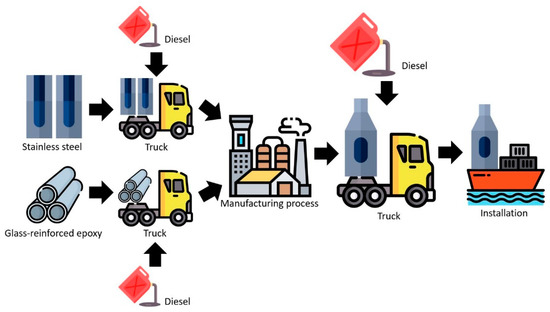
Figure 4.
LCA model for construction phase of scrubber system through GaBi software.
2.4.2. Operation Phase
The emission generated during the ship operation phase is calculated by the electrical energy consumed to operate the scrubber system (see Figure 5). As shown in Table 1, the power and the SFOC of the main engine M/E and A/E of the proposed target ship. It is assumed that the SFOC of M/E and A/E is 160.8 g/kWh and 183 g/kWh, respectively.
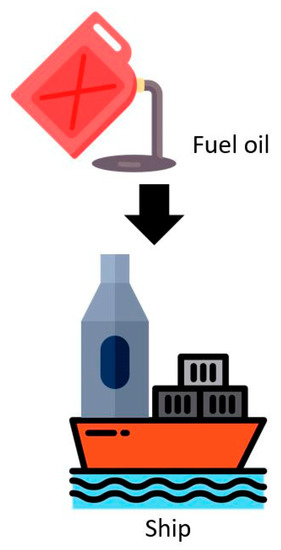
Figure 5.
LCA model for operation phase of scrubber system.
2.4.3. Maintenance Phase
The maintenance phase of the scrubber system assumes that there are no contaminants or potential environmental impacts. Therefore, in this step, the environmental impact is assumed to be zero.
2.4.4. Scrapping Phase
Figure 6 shows the LCA model the of scrapping phase of the scrubber system. The scrapping phase analyses the emission of all processes that occur when the scrubber system is disposed of or recycled. It was assumed that stainless steel which is the main material constituting the scrubber system was recycled, but GRE, which is the main material of the pipeline connecting the scrubber system to the vessel, was discarded. The electrical energy used when recycling stainless steel is summarized in Table 3 and in Figure 6.
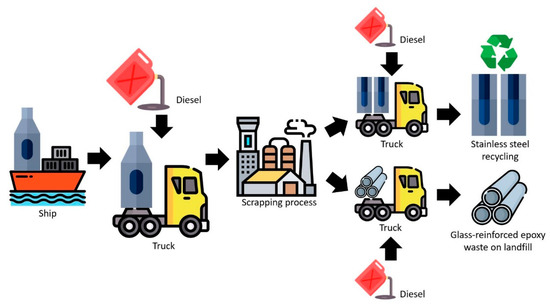
Figure 6.
LCA model for scrapping phase of scrubber system.

Table 3.
The energy consumption and emissions from recycling process [14].
2.5. Technical Impact
Figure 7 shows the process of fuzzy-TOPSIS analysis process, which is expected to supplement the shortcomings of the conventional TOPSIS analysis. To investigate the technical impact of the proposed scrubber systems, the technical analysis was conducted through the linguistic assessment of four former marine engineers experienced in 10 years and over in the maritime sector: maritime professor (E1), class surveyor (E2), ship-owner (E3), marine engineering researcher (E4). The group of experts were requested to perform linguistic ratings on six different attributes in terms of the technical performance of scrubber systems as classified in Table 4.
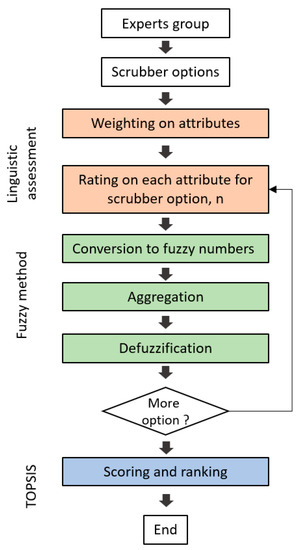
Figure 7.
Fuzzy-TOPSIS method applied to the technical impact assessment.

Table 4.
Attributes applied to fuzzy-TOPSIS for technical impact assessment on scrubber systems.
2.6. MCDM Using Fuzzy-AHP
MCDM analysis was lastly performed with three stakeholder groups (ship-owner, operator and environmentalist) who were subject to weight factors on three different impact categories: economy, environment and technique. MCMD for the final decision was facilitated by means of the Fuzzy-AHP method. Five scales of ‘equally important’, ‘weakly important’, ‘fairly important’, ‘strongly important’ and ‘absolutely important’ were linguistically for relative rating importance to evaluate decision-makers’ preferences, used as a term. The linguistic values from those experts were converted to trapezoidal fuzzy numbers as proposed in Table 5 [15].

Table 5.
Fuzzy numbers for five linguistic scales.
3. Results
3.1. Economic Impact Results
Table 6 shows the estimated cost results from the information of the scrubber system selected in Table 2. The hybrid scrubber is a system that can be applied to both open-loop scrubbers and closed-loop scrubbers, and the initial system cost and installation cost are higher. The operating cost of the scrubber was largely estimated with fuel consumption and the required power of scrubber systems. The expected fuel consumption over 30 years was calculated to be higher because the selected open-loop scrubber has a relatively larger consumption capacity than the closed-loop scrubber. It has been the hybrid scrubber can be used with both open-loop and closed-loop scrubbers, so calculations were made assuming an average value of 225 kW for both systems. As a result, the operating cost of the scrubber turned out to be the most expensive part of the LCCA as it had to be consumed over the life of the vessel for 30 years. In terms of maintenance cost, due to the usage of chemicals over the whole scrubber life cycle, closed-loop scrubbers have been shown to be more expensive than the other two scrubber systems. Finally, Figure 8 reveals the result of LCCA of each scrubber system over the ship life cycle.

Table 6.
Summary of LCCA estimates.
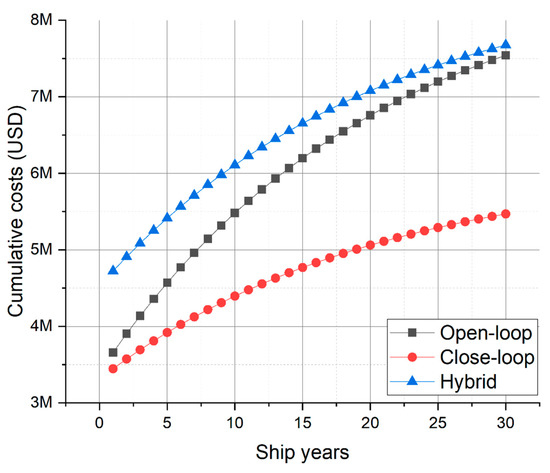
Figure 8.
Cumulative costs for economic impact over ship life cycle.
3.2. Environmental Impact Result
Table 7 shows the environmental impact results of the LCA model produced through GaBi software, and shows the results of the construction, operation and scrapping steps of each scrubber system according to GWP, AP and EP. During the construction phase, a hybrid scrubber system incorporating both open-loop and closed-loop systems was found to emit more environmental emissions than the other two systems. However, these values appear to be completely offset in the operational phase and scrapping phase. In particular, the operation phase shows much higher results than the construction phase and scrapping phase. In the end, the hybrid scrubber system showed the highest environmental impact evaluation results in the construction phase, but the open-loop scrubber system showed the highest results in terms of the entire life cycle. This trend indicates that the required power of the system contributed significantly to the generated emissions. As a result, it turns out that most environmental scrubber system is surprisingly a hybrid scrubber system. However, it should be noted that when the hybrid scrubber system is used only as an open-loop scrubber system, it may produce more environmentally harmful results than the open-loop scrubber.

Table 7.
Summary of LCA estimates.
3.3. Technical Impact Results
In order to compare the technical performance of each scrubber type in various respects, the experts’ opinions can be summarised as shown in Figure 9. According to the survey results, it was found that reliability (A2) and safety (A6) were weighted higher than other attributes. Physical impact (A1) was weighted relatively lower than others. On the other hand, it was also found that the four experts have very similar views on this technical assessment.

Figure 9.
Attribute weights by experts.
The technical survey results are further elaborated through Table 8 and Table 9. In particular, Table 8 shows the results of linguistic assessments from the experts, which were converted to fuzzy numbers as described in Section 2.5. Table 9 presents a general justification behind the experts’ linguistic judgements.

Table 8.
Technical survey results.

Table 9.
Summary of technical assessments.
The Fuzzy numbers were converted from the experts’ linguistic assessments and then, used as inputs for Fuzzy-TOPSIS. Figure 10 presents the results of the technical impact assessment, revealing that the closed-loop scrubber system was evaluated the greatest over the other two systems. Meanwhile, the open-loop scrubber system was identified as the lowest in terms of technical attraction.
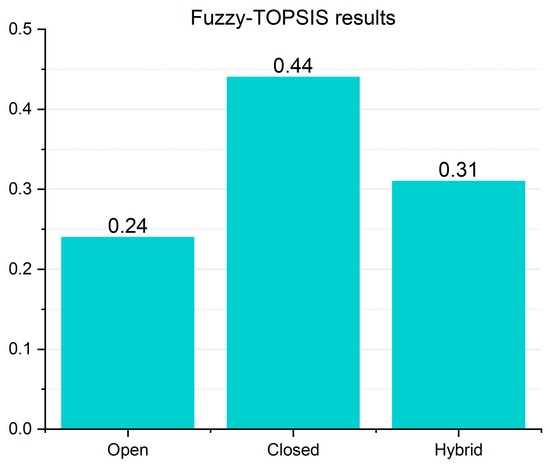
Figure 10.
Results of technical impact; the higher is the greater.
3.4. MDCA Results
Results of the impact assessments conducted in Section 3.1 and Section 3.2 were fed into the Fuzzy-AHP analysis for the final MDCA. For the analysis, this paper employs several different views on weighing factors in each impact category. Given this, it considers that three decision-making groups were assumed: ship operators, ship owners and environmentalists.
Ship operators value the technical impact much higher than the other two counterparts (Case 1). The shipowner is highly interested in the economic impact than the other two impacts (Case 2). Environmentalists argue that environmental impacts outweigh the other two (Case 3). Case 0 was assigned so that all impacts were weighted equally.
Figure 11 summarises the overall MCDA results over four different cases. For Case 0, when the economic, environmental and technical impacts were weighted equally, the closed-loop scrubber system was evaluated as the best option. The same trend is found with the other cases: cases 1–3 where the impact values of the closed-loop scrubber system are relatively lower than the other systems. On the other hand, the open-loop scrubber system was considered the least attractive option across the cases, except for Case 1 where the hybrid system was ranked the lowest due to its high capital costs.

Figure 11.
Results of MCDA (Fuzzy-AHP); the lower is the better.
Meanwhile, ECI demonstrates the economic benefits and costs, enabling the shipowners to make a proper decision when building a new ship or a ship retrofitting. Given this, the ECI is often considered the most important criterion in general as it directly affects their business. Under this circumstance, it should be noted that is more likely to consider the weighting factors for ECI are much greater than others (referring to Case 1) in practice.
4. Discussion and Concluding Remarks
While the environmental regulations are getting stringent, ships engaged in international voyages are grappling with adopting cleaner systems onboard. The proper selection of SOx scrubber systems is exemplary to survive fierce competition in the shipping business. In this respect, this paper suggests a novel approach to support proper decision-making by means of the integration of different academic methods. Therefore, it clearly presents the best option for the SOx scrubber system for the case ship.
Overall research findings suggest the closed-loop scrubber system while presenting its excellence in economic, environmental as well as technical performances. Although this paper dealt with a case-specific study, it is highly believed that such a conclusion would be generally applicable to other ships and cases as a common view. The results of the analysis is also in the same line with the current market trends where the sales of closed-loop scrubber systems are much higher than the other types.
This paper also reassures the effectiveness of the proposed MCDA method which could remedy the shortcomings of the conventional ones. The academic novelty of this paper can be laid in such a methodological demonstration.
The case study conducted in this paper can be considered a demonstrative work on the effectiveness of the proposed method. Given this, the process of the case study was simplified to some extent and their results may need to be further elaborated on in the future study.
Numerous new systems continue to flood the marine industry, which makes it increasingly difficult for designers, operators and service providers to identify the best option among a variety of choices. Meanwhile, conventional practices have shortfalls in examining the overall economic, environmental and technical impacts of those new options.
Given that LCA, MCDA and fuzzy technologies, which can make up for the shortcomings, are still underutilized in the marine industry, this improved hybrid MDCA model will play a significant role in helping the stakeholders to proceed with accurate and reliable decisions.
On the other hand, the proposed hybrid MCDM model may increase the calculation costs/times and complicate the decision-making process. In order to balance those economic and technical issues, it is proposed to develop a general computational tool which will not only facilitate MCDM significantly but also minimise the technical burdens for those who are not familiar with those methods by encapsulating all the technical complexity behind them.
Funding
This research received no external funding.
Institutional Review Board Statement
Not applicable.
Informed Consent Statement
Not applicable.
Data Availability Statement
Not applicable.
Conflicts of Interest
The author declares no conflict of interest.
References
- Kamil, M.S.; Muslim, M.; Saat, A.M. Effective control of SO x and NO x release to the atmosphere from emissions of ship propulsion engines. In Advancement in Emerging Technologies and Engineering Applications; Springer: Berlin/Heidelberg, Germany, 2020; pp. 91–100. [Google Scholar]
- Industry ARC. Marine Scrubber Market-Forecast (2022–2027). 2021. Available online: https://www.industryarc.com/Report/19766/marine-scrubber-market.html (accessed on 20 August 2022).
- Løken, E. Use of multicriteria decision analysis methods for energy planning problems. Renew. Sustain. Energy Rev. 2007, 11, 1584–1595. [Google Scholar] [CrossRef]
- Velasquez, M.; Hester, P.T. An analysis of multi-criteria decision making methods. Int. J. Oper. Res. 2013, 10, 56–66. [Google Scholar]
- Pilavachi, P.A.; Stephanidis, S.D.; Pappas, V.A.; Afgan, N.H. Multi-criteria evaluation of hydrogen and natural gas fuelled power plant technologies. Appl. Therm. Eng. 2009, 29, 2228–2234. [Google Scholar] [CrossRef]
- Üçtuğ, F.G.; Fahrioğlu, M. Multi-criteria decision making-based comparison of fuel cell types for distributed generation applications. In Proceedings of the 16th International Conference on Clean Energy (ICCE-2018), Famagusta, Cyprus, 9–11 May 2018. [Google Scholar]
- Jeong, B.; Oguz, E.; Wang, H.; Zhou, P. Multi-criteria decision-making for marine propulsion: Hybrid, diesel electric and diesel mechanical systems from cost-environment-risk perspectives. Appl. Energy 2018, 230, 1065–1081. [Google Scholar] [CrossRef]
- Yang, J.; Tang, T.; Jiang, Y.; Karavalakis, G.; Durbin, T.D.; Miller, J.W.; Cocker, D.R.; Johnson, K.C. Controlling emissions from an ocean-going container vessel with a wet scrubber system. Fuel 2021, 304, 121323. [Google Scholar] [CrossRef]
- Jang, H.; Jeong, B.; Zhou, P.; Ha, S.; Nam, D.; Kim, J.; Lee, J.-U. Development of parametric trend life cycle assessment for marine SOx reduction scrubber systems. J. Clean. Prod. 2020, 272, 122821. [Google Scholar] [CrossRef]
- Andersson, K.; Jeong, B.; Jang, H.; Environmental Affairs & Shipping. Life cycle and cost assessment of a marine scrubber installation. J. Int. Marit. Saf. Environ. Aff. Shipp. 2020, 4, 162–176. [Google Scholar] [CrossRef]
- ABS. Exhaust Gas Scrubber Systems. 2017. Available online: https://www.ics-shipping.org/current-issue/exhaust-gas-cleaning-systems/ (accessed on 20 August 2022).
- Ship&Bunker. Top Bunker Prices. 2022. Available online: https://shipandbunker.com/ (accessed on 20 August 2022).
- Gilbert, P.; Wilson, P.; Walsh, C.; Hodgson, P. The role of material efficiency to reduce CO2 emissions during ship manufacture: A life cycle approach. Mar. Policy 2017, 75, 227–237. [Google Scholar] [CrossRef]
- Crundwell, F.; Moats, M.; Ramachandran, V.; Robinson, T.; Davenport, W. Recycling of nickel, cobalt and platinum-group metals. In Extractive metallurgy of Nickel, Cobalt and Platinum Group Metals; Elsevier Ltd.: Oxford, UK, 2011; pp. 537–549. [Google Scholar]
- Chen, S.-J.; Hwang, C.-L. Fuzzy multiple attribute decision making methods. In Fuzzy Multiple Attribute Decision Making; Springer: Berlin/Heidelberg, Germany, 1992; pp. 289–486. [Google Scholar]
- The Glosten Associates. Exhaust Gas Cleaning Systems Determining Economics of Scrubber Systems; The Glosten Associates: Seattle, WA, USA, 2013. [Google Scholar]
- Shu, S.-T. A Life Cycle Cost Analysis of Marine Scrubber Technologies. Master’s Thesis, University of Rostock, Rostock, Germany, 2013. [Google Scholar]
Publisher’s Note: MDPI stays neutral with regard to jurisdictional claims in published maps and institutional affiliations. |
© 2022 by the author. Licensee MDPI, Basel, Switzerland. This article is an open access article distributed under the terms and conditions of the Creative Commons Attribution (CC BY) license (https://creativecommons.org/licenses/by/4.0/).